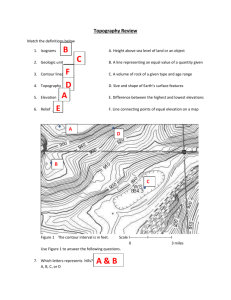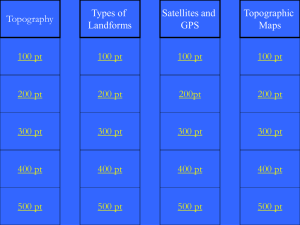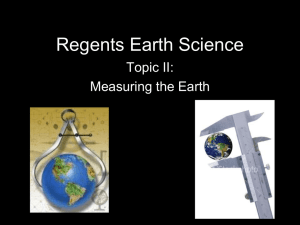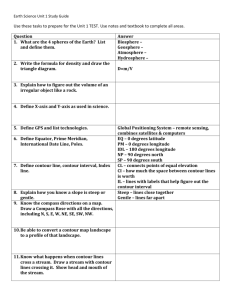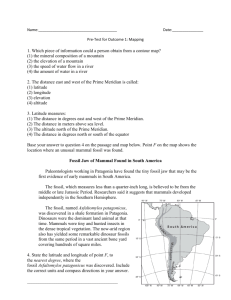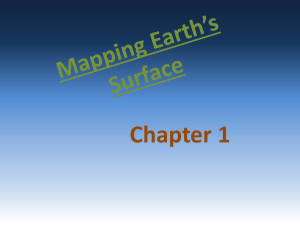IS Chapter 1 Notes
advertisement
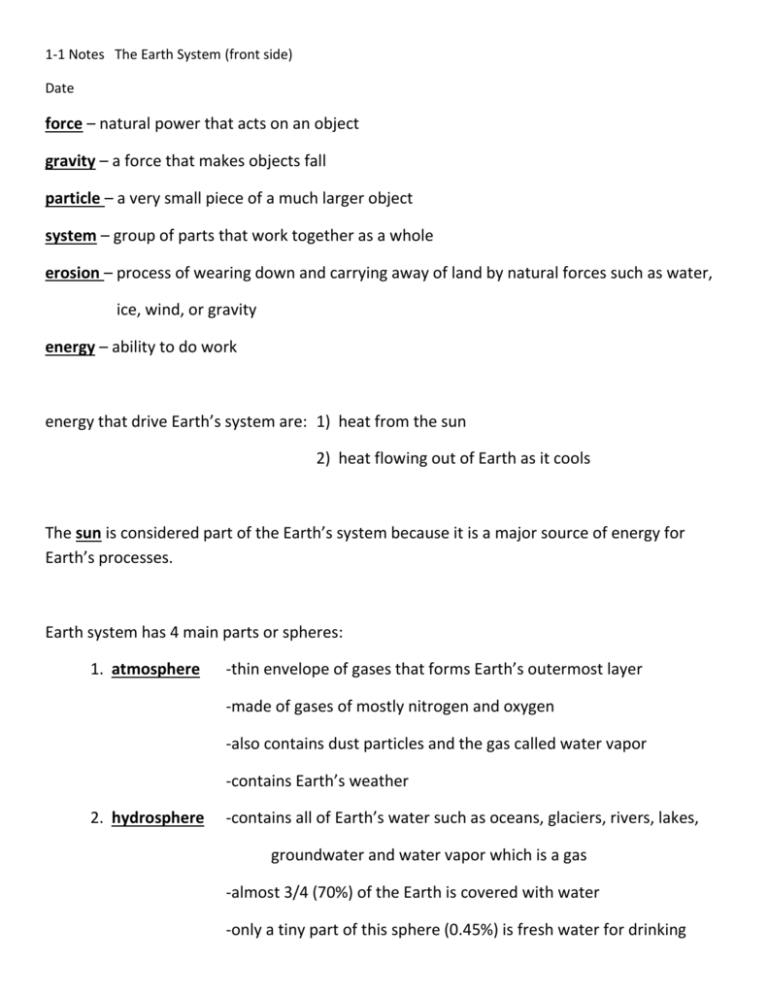
1-1 Notes The Earth System (front side) Date force – natural power that acts on an object gravity – a force that makes objects fall particle – a very small piece of a much larger object system – group of parts that work together as a whole erosion – process of wearing down and carrying away of land by natural forces such as water, ice, wind, or gravity energy – ability to do work energy that drive Earth’s system are: 1) heat from the sun 2) heat flowing out of Earth as it cools The sun is considered part of the Earth’s system because it is a major source of energy for Earth’s processes. Earth system has 4 main parts or spheres: 1. atmosphere -thin envelope of gases that forms Earth’s outermost layer -made of gases of mostly nitrogen and oxygen -also contains dust particles and the gas called water vapor -contains Earth’s weather 2. hydrosphere -contains all of Earth’s water such as oceans, glaciers, rivers, lakes, groundwater and water vapor which is a gas -almost 3/4 (70%) of the Earth is covered with water -only a tiny part of this sphere (0.45%) is fresh water for drinking 1-1 Notes The Earth (back side) Date 3. geosphere -contains most of the Earth’s mass -has 3 main parts: 1) metal core 2) solid middle layer 3) rocky outer layer 4. biosphere feedback -the part of Earth that contains living organisms (plants and animals) -data a system returns (feedbacks) to itself about a change in the system -demonstrates how changes in on part of Earth system might affect the other parts Lands are constantly being created and destroyed by forces. 1. constructive forces – shape the land’s surface by building up mountains and other landforms 2. destructive forces – destroy and wear away landmasses through processes like erosion and weathering (the chemical and physical process that break down rock and other substances). 1-2 Notes Earth’s Interior (front side) Date 2 main types of evidence about Earth’s interior: 1. direct evidence (you can see it) - from rock samples 2. indirect evidence (you cannot see it) – from seismic waves (vibrations that travel through Earth carrying the energy released during an earthquake) whose speed and path of the waves gives clues to the structure of the Earth Earth’s interior is made up of 3 main layers: 1. crust -layer of rock that forms Earth’s outer skin -contains layer of solid rock including dry land and ocean floor -made up of several elements with oxygen and silicon as the most -on average 5-40 km thick (thickest under the continental crust) (thinnest under the oceanic crust) 2. mantle -thickest layer -approximately 3000 km of solid rigid rock -divided into layers based on physical characteristics: 1) lithosphere - layer is crustal and mantle material that is brittle (easily broken) so contains plates 2) asthenosphere - layer below the lithosphere of less rigid very hot solid ductile (bendable) rock which has plasticity (ability to flow or change shape like a liquid 3) mesosphere – layer beneath the asthenosphere that is the more rigid lower part of the mantle 1-2 Notes Earth’s Interior (back side) Date 4. core - at the center of the planet with a thickness of approximately 3480 km -below the mantle -mostly made of iron and nickel -consists of 2 parts: 1) liquid outer core with a thickness of 2258 km 2) solid inner core with a thickness of 1222 km The movement of the liquid outer core create Earth’s magnetic field (protects Earth from deadly particles streaming from the sun). The Earth’s magnetic north pole is not the same as the Earth’s geographic North Pole. pressure – force pushing on a surface divided by the area of the surface As your go deeper(greater depth) inside the Earth to the core, the pressure and temperature are greater. basalt – dark, fine-grained rock of the oceanic crust granite – light color, course-grained rock of the continental crust 1-3 Notes Convection and the Mantle Date fluid – a liquid or gas because they flow heat transfer -movement of energy from a warmer object to a cooler object -constantly happening inside and around the Earth ex sun warms the ground -heat always moves from a warmer object to a cooler object 3 types of heat transfer: 1. radiation -transfer of energy by electromagnetic waves -waves move through empty space -ex sun’s warmth, heat above stove or a fire 2. convection -transfer of thermal (heat) energy by movement of a fluid -ex warm air from a heater rises, cooler air sinks 3. conduction -transfer of thermal energy from one particle of matter to another (by touching) -ex feet on hot sand, melting ice cubes in a hand heat food in a pan, heating pad on muscles convection current -heating and cooling of a fluid changes the fluids density -warm air is less dense so it rises and the force of gravity causes the cooler denser air to sink -heat from the core and mantle act like a stove causing convection currents in the mantle 1-4 Notes Exploring Earth’s Surface topography – the shape of the land determined by 3 things: 1. elevation - height above sea level (where the water meets the land) 2. relief -difference ( meaning subtraction) in the elevation between the highest and lowest parts of an area -low relief - small difference in elevation ex plain -high relief – great difference in elevation ex mountain 3. landforms - a shape or feature of the land 3 major types of landforms: 1. plains -a landform made up of flat or gently rolling land with low relief -two types of plains 1) coastal plains (low elevation and low relief) ex Atlantic beaches 2) interior plains (varying elevation and low relief) ex Great Plains of central U. S. 2. mountains -landform with high elevation and high relief with a summit (peak) -mountain range – group of mountains - The Himalayas mountain range is the world’s highest -mountain system – group of mountain ranges -mountain belt – group of mountain systems connected in a chain 3. plateaus – a landform that has high elevation and little or no relief (flat on top) landform regions – a large area of land where the topography is made up mainly of one type of land form ex Great Plains, Rocky Mountains, Colorado Plateau 1-5 Notes Models of Earth (front side) Date globe – sphere that represents Earth’s entire surface showing shapes, sizes, and positions map – a flat model of all or part of Earth’s surface map projection- framework of lines that helps transfer points on Earth’s surface onto a flat map ex Mercator projection (size and shape of landmasses become more and more distorted toward the North Pole and the South Pole map’s symbols – a picture used by map makers to stand for features on Earth’s surface map’s key – a list of symbols used on a map and their meanings map’s scale- used to relate distance on a map/globe to the actual distance on Earth’s surface Because Earth is a sphere, distance on Earth is measured in degrees, totaling 3600 , with smaller units of minutes and seconds. equator - an imaginary line that circles the Earth halfway between the North and South Poles called the great circle hemisphere -one half of the sphere that makes up Earth’s surface -the equator divides Earth into the northern and southern hemispheres 1-5 Notes Models of Earth (back side) prime meridian -an imaginary line that makes a half circle starting at the North Pole and ending at the South Pole -places east of the prime meridian are in the eastern hemisphere and places west of the prime meridian are in the western hemisphere latitude -distances, in degrees, north or south of the equator -equator is 00 with smaller and smaller circles until the poles are reached at 900 longitude -distance, in degrees, east and west of the prime meridian -prime meridian is 00 and each hemisphere has 1800 ,half in the western hemisphere and half in the eastern hemisphere for a total of 3600 - The distance in a longitude belt is not equal ex 10 = 111 km at the equator and 00 at the poles. Any location on the Earth’s surface can be found using BOTH latitude and longitude. time zones -a longitude belt of the Earth in which all areas have the same local time. -there is 150 of longitude in each belt because 3600 divided by 24 hours = 15. -there are 4 time zones in the continental U. S. (eastern, central, mountain and Pacific) and 6 time zones including Alaska and Hawaii. international date line located along the 1800 longitude line to mark the beginning of a new day going west over the line and repeating a day going east over the line. -the line zigzags to avoid land 1-6 Notes Topographic Maps Date topgraphical map -a map that shows the surface features of an area as if you were looking down on it from above -provides accurate information of the elevation, relief, and slope of the ground contour line -a line on a topographic map that connects points of equal elevation -closely spaced contour lines indicate a steep slope -widely spaced contour lines indicate a gentle slope contour interval -the difference (subtraction) in elevation from one contour line to the next -on one map, all contour intervals are the same index contour – every 5th contour line is darker on an official topographical map hachure marks – little lines inside the contour lines that indicate a depression (elevation that goes down) ex hole in the ground, lake, pond A V shaped contour line has the point of the V at the river’s source and the opening of the V showing where the river is flowing.
